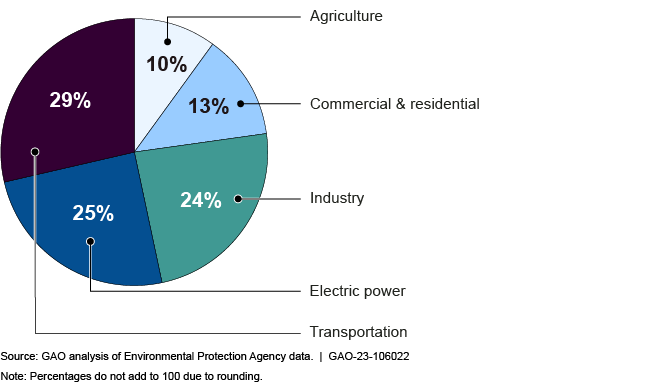Climate Change: State and Local Efforts to Reduce Greenhouse Gas Emissions from Vehicles
Fast Facts
The transportation sector is the largest source of greenhouse gas emissions in the U.S.
State and local agencies play a key role in helping to reduce greenhouse gas emissions from vehicles—such as by investing in electric vehicle infrastructure that could reduce emissions.
However, some of these agencies face challenges, including:
Lacking readily available emissions data or staff with the right subject matter expertise
Trouble quantifying the effects of investments over time—such as adding bike lanes—on greenhouse gas emissions
Not having many ways to incentivize consumers to use particular fuels or vehicles
Total U.S. Greenhouse Gas Emissions by Economic Sector in 2021

Highlights
What GAO Found
According to the Federal Highway Administration (FHWA), state departments of transportation (state DOT) and metropolitan planning organizations (MPO) play a key role in implementing activities to reduce transportation-related greenhouse gas emissions, including on-road emissions from vehicles. GAO found examples of state DOTs and MPOs engaging in these activities, including estimating emissions, analyzing the effects of transportation investments, and using reduction targets.
- Estimating emissions. GAO found examples of state DOTs and MPOs estimating on-road greenhouse gas emissions using different types of data as the basis of those estimates. These entities more commonly used data on vehicle miles traveled (e.g., annual traffic count data), while others used fuel data (gallons of fuel taxed by the state). The selected state DOTs that do not currently estimate on-road greenhouse gas emissions cited a number of reasons. For example, Montana state DOT officials said the majority of roads in the state are rural with no congestion issues. Officials from selected MPOs provided examples of resource challenges they face, such as not having readily available data or staff with the right subject matter expertise.
- Analyzing the effects of transportation investments. GAO found examples of state DOTs and MPOs analyzing the effects of transportation investments on greenhouse gas emissions. For example, officials from an MPO in Massachusetts said that they estimate emissions changes for every project the MPO funds. However, selected state DOTs and MPOs reported challenges to reliably quantifying the effects of specific investments on greenhouse gas emissions.
- Using reduction targets. GAO found a few examples of selected state DOTs and MPOs that have targets for reducing on-road greenhouse gas emissions. For example, the MPO representing the Washington, D.C. metropolitan area set targets to reduce on-road greenhouse gas emissions by 50 percent from 2005 levels by 2030, and 80 percent by 2050. However, selected state DOT and MPO officials provided examples of challenges to meeting reduction targets, such as having few ways to incentivize consumers to adopt particular fuels or vehicles.
Vehicle Traffic Congestion and On-Road Emissions

Why GAO Did This Study
Greenhouse gas emissions contribute to climate change, which numerous studies have shown poses environmental and economic risks. The transportation sector is the largest source of greenhouse gas emissions in the U.S., with transportation activities accounting for 29 percent of total U.S. emissions in 2021, according to the Environmental Protection Agency. The vast majority of these emissions occur on the nation's 4-million-mile network of roads, most of which are owned and operated by state and local governments.
The Explanatory Statement on the Consolidated Appropriations Act, 2022 included a provision for GAO to examine the extent to which states and MPOs collect performance information on transportation-related greenhouse gas emissions, among other things. This report describes activities selected state DOTs and MPOs have taken related to estimating, analyzing the effects of transportation investments on, and using reduction targets for on-road greenhouse gas emissions.
GAO reviewed federal statutes, regulations, executive orders, and other information on greenhouse gas emissions. GAO also interviewed federal officials as well as officials from a non-generalizable selection of 10 state DOTs and 10 MPOs. GAO selected states that varied in greenhouse gas emission policies, population, and geographic area, and generally selected the largest MPO from each of these states.
For more information, contact Elizabeth Repko at (202) 512-2834 or repkoe@gao.gov.
